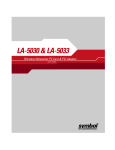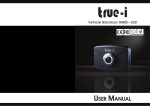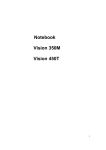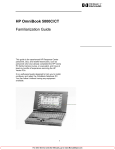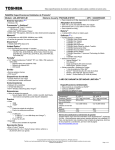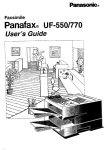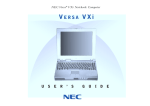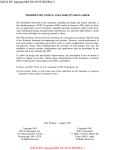Download Notice Trademark Warranty Provisions
Transcript
Notice Updating or revising this manual or making any changes to the information herein will be initiated when the company deems it necessary. The company reserves the right to take the above-mentioned actions and is under no obligation to notify any person of such actions in advance or afterwards. 1997 Trademark MS-DOS, Microsoft Windows, Windows NT and Microsoft Mouse are registered trademarks of Microsoft Corporation. IBM PC, OS/2, PS/2, EGA, and VGA are registered trademarks of International Business Machines Corporation. Intel, Pentium are trademarks of Intel Corporation. AMI is a trademark of American Megatrends, Inc. Other brand and product names are trademarks of their respective companies. Warranty Provisions Warranties for the Notebook Computer may vary with different areas. If you have any questions, please call your local dealer with the serial number of your unit, and you will be provided with all warranty information you need. The manufacturer is not liable to any purchaser for damage, lost revenue, lost wages, lost savings, or any other incidental or consequential damages arising from the purchase or use of the product or inability to use the product. 1 FCC Notice This equipment has been tested and found to comply with the limits for a Class B digital device, pursuant to Part 15 of the FCC Rules. These limits are designed to provide reasonable protection against harmful interference in a residential installation. This equipment generates, uses, and can radiate radio frequency energy and, if not installed and used in accordance with the instructions, may cause harmful interference to radio communications. However, there is no guarantee that interference will not occur in a particular installation. If this equipment does cause harmful interference to radio or television reception, which can be determined by turning the equipment off and on, the user is encouraged to try to correct the interference by one or more of the following measures: l Reorient or relocate the receiving antenna. l Increase the separation between the equipment and receiver. l Connect the equipment into an outlet on a circuit different from that to which the receiver is connected. l Consult the dealer or an experienced radio/TV technician for help. CE - Certificate This model is in compliance with the requirements of the following regulation: EN 55 022: CLASS B 2 Important Safety Instructions Please read and follow these important instructions. 1. Follow all warnings and instructions marked on this product. 2. Unplug this product from the wall outlet before cleaning it or connecting peripheral devices. 3. Use a damp cloth with mild soap to clean this product. Do not apply cleaner directly to the unit. Do not use volatile or abrasive cleaners on this product. 4. Do not place this product on an unstable surface where it may fall. 5. Do not block or cover the system's ventilation openings. Also, never place this product near or over a radiator or heat register, or in a built -in installation unless adequate ventilation is provided. 6. Operate this product in accordance with its rated power specifications. If you are unsure of your local power specifications, consult your dealer or local power company. 7. This product is equipped with a 3-wire grounding type plug. This is an important safety feature; do not defeat its purpose. If you do not have access to such power, have a qualified electrician install a proper outlet. 8. Do not allow anything to rest on the power cord. Do not locate this product where persons will likely walk on the cord. 9. If an extension cord is used with this product, make sure the total current drawn by the products plugged into the extension cord do not exceed the extension cord or outlet power ratings. 10.Do not allow foreign matter to enter the system. 11.Do not attempt to service this product yourself. Opening or removing covers may expose dangerous voltage points. Refer all repair work to qualified service personnel. 12.Unplug this product from the wall outlet, do not operate it, and immediately seek proper servicing if: ü The power cord or plug is damaged or frayed. ü Liquid or foreign matter has entered this product. ü This product has been exposed to rain or water. ü This product has been dropped or damaged. ü This product exhibits a distinct change in performance, indicating a need for service. 13.Do not use any battery pack other than the one specifically designed for this system. Batteries may explode or leak if exposed to fire or improperly handled or guarded. Refer battery replacement to your dealer or qualified service personnel. 14.Only use UL listed/CSA certified, type SVT/SJT power cords rated 6A 250V minimum (VDE approved or equivalent). It should be a detachable type with a minimum length of 6 feet. 15.Adjust only those controls that are covered by these operating instructions. Improper adjustment of other controls may result in serious damage to the system which is not covered by the warranty. 3 Table of Contents Chapter 1 Getting Started Unpacking.......................................................................................................... 7 Operating Environment........................................................................................ 8 System Features ................................................................................................. 9 Quick Starting-Up............................................................................................... 11 Powering the System................................................................................... 11 Opening the LCD Cover.............................................................................. 12 Portable Operation...................................................................................... 13 Primary battery Pack........................................................................... 13 Secondary Battery Pack....................................................................... 14 Charging Battery Packs ....................................................................... 15 DURACELL Rechargeable Battery Compatible ................................. 15 Proper Handling of Battery Packs......................................................... 15 Top-Front View.................................................................................................. 17 LCD Panel................................................................................................. 17 Dual Stereo Speakers .................................................................................. 17 LCD Bar .................................................................................................... 17 Trackpad.................................................................................................... 17 Windows 95 Keyboard................................................................................ 17 LEDs, Power Switch, and Microphone................................................................. 19 LCD Bar............................................................................................................ 20 Right Side View.................................................................................................. 21 PC Card Sockets......................................................................................... 21 5.25” CD-ROM Drive................................................................................. 21 Infrared ...................................................................................................... 21 Ventilation Grids.......................................................................................... 21 Headphone Jack.......................................................................................... 21 Line-in Jack................................................................................................ 21 Microphone-in Jack..................................................................................... 21 Right-Side Stand.......................................................................................... 21 Left Side View................................................................................................... 23 2.5” Removable Hard Disk.......................................................................... 23 3.5” Floppy Disk Drive ................................................................................ 23 Primary Battery Pack and Latch.................................................................. 23 Left-Side Stand........................................................................................... 23 4 Rear View ......................................................................................................... 25 AC-in Socket.............................................................................................. 25 Serial Port (COM2)..................................................................................... 25 MIDI/Game Port ........................................................................................ 25 External Monitor (CRT) Port....................................................................... 25 Serial Port (COM1)..................................................................................... 25 Parallel Port................................................................................................ 25 PS/2 Type Port........................................................................................... 25 Chapter 2 Operating Upgrading CPU.................................................................................................. 28 Replacing CPU........................................................................................... 28 ZIF Socket Operation .................................................................................. 30 Updating BIOS................................................................................................... 31 Expanding Memory............................................................................................. 32 Using Hot Keys .................................................................................................. 34 Using PC Card Sockets....................................................................................... 35 Replacing Hard Disk Drive.................................................................................. 37 Replacing Floppy Disk Drive ............................................................................... 39 Using CD-ROM................................................................................................. 40 Using Embedded Numeric Keypad...................................................................... 41 Using Power Management.................................................................................. 42 Doze .......................................................................................................... 42 Suspend and Resume................................................................................... 42 Display Idle................................................................................................. 42 Hard Disk Idle ............................................................................................ 42 Advanced Power Management.................................................................... 42 Chapter 3 BIOS Utilities Power On Self Test (POST) ............................................................................... 43 POST: Normal Operation............................................................................. 43 POST: Error Detected................................................................................. 43 WINBIOS Setup ................................................................................................ 44 Invoking WINBIOS Setup........................................................................... 44 Working with WINBIOS Setup.................................................................... 45 Help........................................................................................................... 46 Standard Setup............................................................................................ 47 Advanced Setup.......................................................................................... 48 Power Management Setup........................................................................... 50 5 Peripheral Setup.......................................................................................... 52 Security ...................................................................................................... 54 Utility ......................................................................................................... 56 Default....................................................................................................... 57 Exit ............................................................................................................ 58 0V Suspend Utility.............................................................................................. 59 6 Chapter 1: Getting Started This chapter provides a short introduction and tutorial that will familiarize you with the Notebook system and get you up and running quickly. Unpacking Carefully unpack the Notebook Computer and its included accessories. If there are any discrepancies or problems, contact your dealer immediately. Be sure to save the packing materials in the case you need to repack and ship the Notebook back in the future. l l l l l l l l Notebook Computer. Carrying bag. Power adapter. Power cord. User manual. PS/2 transfer cable. Utilities diskette(s). Compact Disk. 7 Operating Environment Thanks to the Notebook’s ability to run on battery power, its compactness in size, and light weight, it can be conveniently operated wherever the temperature and humidity are comfortable enough for you to work. If you properly care for the Notebook, it will provide many years of reliable service. However, remember this computer system is a precision instrument and it should not be: l l l l Exposed to excessive heat or direct sunlight. Subjected to shock or vibration. Exposed to strong magnetic fields. Left in a place where foreign matter or moisture may enter the system. 8 System Features The Notebook Computer is a state-of-the-art, high performance, portable system. It offers a host of features specially designed to enhance performance and usability. l CPU ü Intel P54C. ü Intel P54LM. ü Intel P55C with MMX technology. l Memory ü 3.3 V power supply. ü Supports Fast Page Mode/EDO. ü 512KB secondary cache PBSRAM. ü 8MB expandable up to 128MB. ü 8/16/32/64MB 144-pin SODIMM RAM modules (option). l System BIOS ü 256KB flash ROM. ü PCI 2.1. ü Plug and Play 1.0a. l Display ü 11.3” TFT SVGA (800x600 pixels) LCD panel available. ü 12.1” TFT SVGA (800x600 pixels) LCD panel available. ü 12.1” DSTN SVGA (800x600 pixels) LCD panel. ü 2MB display memory (EDO). ü Simultaneous display with an external monitor. l Input/Output ü Built-in trackpad (PS/2). ü Serial ports (COM1, COM2). ü Parallel port. ü CRT port. ü Game port. ü PS/2 type port. ü Headphone jack, Microphone-in jack, Line-in jack. 9 l PC Card Sockets ü One Type III or two Type II PC cards. l Mass Storage ü 2.5” (12.7mm high or less) hard disk drive. ü 3.5” floppy disk drive (interchangeable). ü 5.25” CD-ROM. l Infrared Wireless Communication ü IrDA (HPSIR). ü ASKIR. l Audio ü Sound Blaster Pro compatible. ü Built-in microphone. l Power Management ü Doze mode. ü Suspend/Resume. ü Display idle mode. ü Hard disk idle mode. ü APM 1.2. l Rechargeable battery Pack ü Ni-MH or Li-Ion available. ü Battery low warning. ü Auto-switching with AC power adapter. ü Secondary Battery Pack (option). l AC Power Supply ü External Model: AC-D01 ü Alternative Model: F1650L l Size & Weight ü 302mm(w)x234mm(d)x54mm(h) ü 3.4kg. 10 Quick Starting-Up Powering the System Use only the Power Adapter that comes with your Computer. System operation with an incorrect power adapter will cause damage to the Notebook and its components. 1. Connect the power cord to the power adapter. 2. Plug the power adapter to the AC-in socket on the rear panel of the Notebook. 3. Plug the AC power cord into a properly grounded outlet. 11 Opening the LCD Cover 1. 2. 3. 4. Slide the top cover latch to the right to release the latch. Lift the top cover to reveal the LCD panel and keyboard. Raise the LCD panel to a comfortable viewing angle. Press the power button once to turn the system on, once to turn it off. 12 Portable Operating Primary Battery Pack The Notebook system can be powered by battery pack for continuous portable operation without an external power source when you take it away from the office. The actual operating time, however, will be dependent upon the application you use and the configuration you set. Inserting 1. Open the battery access door on the left side of the Notebook. 2. Slide the battery into the compartment until the latch clicks into place. 3. Close the access door. Removing 1. Open the access door. 2. Press the battery latch upward to pop up the battery pack. 3. Pull the battery pack out of the compartment. 13 Secondary Battery Pack (Option) When you need prolonged use without the availability of the AC adapter, you may consider a spare battery, called Secondary Battery Pack, for optimal portable operation. Insert the battery pack into the proprietary bracket to have your system powerful. Contact your dealer for more information. 1. Turn the Notebook off. 2. Turn the Notebook over. 3. Locate the FDD (Floppy Disk Drive) latch. 4. Press the latch in the illustrated direction and pull the Floppy Disk Drive out of the compartment. 5. Slide the Secondary Battery Pack all the way into the empty compartment. Remove 3.5” FDD Insert Second battery 14 Charging Battery Packs Off-Line Charge The Notebook system is powered off. Connect the AC adapter to the unit. Its DC output will be used solely to charge the battery. It will take hours to bring a completely discharged battery to its full charge state. Trickle Charge The Notebook system is powered on. Again, make sure the AC adapter is connected to the unit. Its DC output will both power the system and charge the battery. It may take more hours than off-line charge to charge the battery. DURACELL Rechargeable Battery Compatible The Notebook system is compatible with DURACELL rechargeable battery: m DR36 nickel-metal hydride (Ni-MH) rechargeable battery m DR202 Lithium ion (Li-Ion) rechargeable battery The DURACELL battery comes with a charge indicator button. Simply press the indicator button to get informed of the reamining battery life. Read its instrtuctions before using the battery. Proper Handling of Battery Packs ü Do not attempt to disassemble the battery under any circumstances. ü The battery may explode if exposed to fire or high temperatures. ü Avoid short circuit the battery by the metal terminals (+, −). 15 16 Top-Front View A. LCD Panel The LCD display is SVGA (800x600 pixels) compatible and driven by a PCI local bus video controller with 2MB video memory providing high performance and crystal clear resolution. It measures 11.3”/12.1” diagonally either with Thin Film Transistor (TFT) technology or 12.1” Dual-scan Super Twisted Nematic (DSTN) technology. B. Dual Stereo Speakers Dual built-in speakers provide clear stereophonic sound. C. LCD Bar The Notebook features the LCD bar which displays the status of various devices. The symbols defined later will appear on the LCD bar when appropriate. D. Trackpad The pointing device features a sensitive glide pad for precise movements. It functions like a two-button mouse does. The right trackpad button is equivalent to the right mouse button; the left trackpad button is equivalent to the left mouse button. E. Windows 95 Keyboard The Notebook utilizes an 86 key Windows 95 keyboard. It is detachable for various language versions. 17 A B C D E 18 LEDs, Power and Microphone Icon Icon Color of Light Green Red Orange Green Red Orange Function Power Switch Microphone Description System power on (either by AC or by battery) Battery in charge when system power off Battery in charge when system power on Primary battery fully charged Secondary battery fully charged Both batteries fully charged Description Toggle the power switch to turn the system on or off. This is the built-in microphone for audio input. 19 System Status LCD Bar Icon Description AC power is used. Battery power is critically low. CD-ROM is accessing. Floppy Disk Drive is accessing. Hard Disk Drive is accessing. The system has entered the 5V-Suspend mode. The CPU is running at the maximum speed. Scroll lock function is activated. Caps lock function is activated. Num lock function is activated. 20 Right Side View A. PC Card Sockets One Type III or two Type II PC cards may be used. The ejection button for the upper slot is located on the left. The eject button for the lower slot is on the right. Both sockets will expand the system capabilities when a PC card is inserted. B. 5.25” CD-ROM Drive The 5.25” IDE CD-ROM is installed in this compartment. The eject button is located in the middle of the front cover of the drive. Pressing it will release the CD tray. C. Infrared The Notebook provides an infrared communication that is IrDA compliant. It can be used to make a cordless connection between the system and an IrDA compliant device. D. Ventilation Grids The ventilation grids are necessary to dissipate heat. Do not block or obstruct them during operation. E. Headphone Jack Headphone can be attached to the system through this jack, so can external speakers that have built-in output power amplifier. F. Line-in Jack External audio source can be fed into the Notebook through this jack. G. Microphone-in Jack Use this jack to connect a microphone to the system. H. Right-Side Stand Move this stand (together with the left one) to adjust the typing angle. If a high speed CPU is installed on the system, erecting the stands on both sides will be necessary for heat dissipation during operation. 21 A E F G G C B D 22 H Left Side View A. 2.5” Removable Hard Disk Drive This compartment houses a removable 2.5” hard disk drive. To replace the hard disk, open the cover then pull out the hard disk gently. B. 3.5” Floppy Disk Drive The Notebook comes standard with a 1.44MB floppy drive installed. You may press the button on its top-right side for diskette ejection. This compartment may also be used for optional accessory, such as the Secondary Battery Pack. C. Primary Battery Pack and Latch This compartment houses a removable and rechargeable battery pack. Pressing the battery latch upward will pop up the battery pack. D. Left-Side Stand Move this stand (together with the right one) to adjust the typing angle. If a high speed CPU is installed on the system, erecting the stands on both sides will be necessary for heat dissipation during operation. 23 A D C B 24 Rear View A. AC-in Socket Plug the AC adapter into this connector for power supply. To disconnect the power adapter, pull the plug (not the cord) directly back. B. Serial Port (COM2) This RS232 port is UART 16C550 compatible. It is defined as COM2. C. MIDI/Game Port This port is used for connecting a MIDI keyboard or instrument. A standard joystick may also be connected. D. External Monitor (CRT) Port This port is used for display output to an external monitor. Simultaneous display with the LCD panel is available. E. Serial Port (COM1) This RS232 port is UART 16C550 compatible. It is defined as COM1. F. Parallel Port This parallel port supports EPP (Enhanced Parallel Port) and ECP (Extended Capabilities port) modes. G. PS/2 Type Port This port is used to connect an external PS/2 mouse or keyboard. 25 A B C D E 26 F G Chapter 2: Operating The Notebook has many advanced features to help you with your computing work. This Chapter describes each of the Notebook’s hardware features and show you how to use them. Before you begin working with any internal components of the Notebook, removal all batteries and disconnect the AC power adapter. Make sure that you wear an anti-static wrist strap to ground yourself before working with any internal components of the Notebook. Static electricity may damage components beyond repair. l l l l l l l l l l Upgrading CPU. Updating BIOS. Expanding Memory. Using Hot Keys. Using PC Card Sockets. Replacing Hard Disk Drive. Replacing Floppy Disk Drive. Using CD-ROM. Using Embedded Numeric Keypad. Using Power Management. 27 Upgrading CPU The system is capable of hosting a wide range of Intel CPUs’ speed. Upgrading your CPU will increase your computing speed. Different CPUs may have different power voltages. The Notebook comes standard with 3.3 volt CPU. If you upgrade CPU at other power voltage than 3.3V, contact your dealer to obtain the CPU Power Module to set the required power voltage. Both CPU frequency and CPU voltage are configurable by DIP Switches. Setting CPU Speed 1. Turn the Notebook over. 2. Remove the CPU cover. 3. Remove the two screws that fasten the bracket mounted on the heat sink. 4. Remove the four screws that fasten the heat sink mounted on the CPU. 5. Locate the DIP Switch SW2 to set the proper configuration for CPU frequency. SW2-3 SW2-4 SW2-5 SW2-6 SW2-7 CPU Speed Off Off Off Off Off 90 MHz Off On Off Off Off 100 MHz Off Off Off On Off 120 MHz Off On Off On Off 133 MHz Off Off On On Off 150 MHz Off On On On Off 166 MHz Off On On Off Off 200 MHz Off On Off Off Off 233 MHz Off On Off On On 266MHz Off On On On On 300MHz Setting CPU Power Find the 4-pole DIP Switch on the CPU Power Module to set the power voltage of the CPU you just installed. Refer to the user guide of the installed CPU to make sure which power voltage you should set. Incorrect setting will cause damage to both the system and the CPU. SW1 SW2 SW3 SW4 CPU Power On Off Off Off 2.2V Off On Off Off 2.45V Off Off On Off 2.8V 28 l The back side of heat sink (Washer for AMD K6 only) Washer Thermal Pad Heat Sink Set for CPU power CPU Power Module Set for CPU speed 29 ZIF Socket Operation A ZIF (Zero Insertion Force) socket is provided to facilitate CPU removal and installation for you. You may need to contact your dealer for the proprietary tool to work with the ZIF socket. Improper tool or incorrect operation may damage the socket. l Insert the proprietary tool into the OPEN position of the ZIF socket. Move the screwdriver to the right to unlock the CPU. l Align the index corner to install the CPU in place. Index corner l Insert the proprietary tool into the CLOSE position of the ZIF socket and lever to the left to lock the CPU. 30 Updating BIOS In order to keep up with the latest system BIOS, you may upgrade your Notebook system from available source, your dealer for example. Continue the process that you work with CPU processors. The DIP Switch SW2-1 and SW2-2 need to be set ON when you are going to update the existing system BIOS. But you should set them back OFF after updating BIOS is complete. DIP Switch (SW2) SW2-1 Off On Purpose Flash ROM BIOS Existing BIOS Updating BIOS SW2-2 Off On 31 Expanding Memory The system has two memory sockets for different RAM Modules to expand the memory up to 128MB. These RAM Modules are 144-pin SODIMM (Small Outline Dual In-line Memory Module) type. The Notebook supports Fast Page Mode, EDO operation. With the following memory configurations, the total memory size will be automatically detected by the POST routines: Bank 0 (64-bit) Bank 1 (64-bit) (1Mx16)x4 None (1Mx16)x4 (1Mx16)x4 (1Mx16)x8 None (2Mx8)x8 None (1Mx16)x8 (1Mx16)x4 (4Mx16)x4 None (2Mx8)x8 (2Mx8)x8 (1Mx16)x8 (1Mx16)x8 (4Mx16)x4 (4Mx16)x4 (4Mx16)x8 None (8Mx8)x8 None (4Mx16)x8 (4Mx16)x4 (4Mx16)x8 (4Mx16)x8 (8Mx8)x8 (8Mx8)x8 Power Speed 3.3V 70ns/60ns 32 Total Size 8MB 16MB 16MB 16MB 24MB 32MB 32MB 32MB 64MB 64MB 64MB 96MB 128MB 128MB Bank 0 Bank 1 33 Using Hot Keys Located on the bottom-left edge of the keyboard layout is a colored Fn key. It is a special key only found on the Notebook to make key combination with other keys for easy access to system features. Hold down the Fn key while pressing other key as below: Hot Keys Fn + F3 Fn + F4 Fn + F6 Fn + F9 Fn + F10 Fn + F11 Fn + F12 Fn + Z Fn + Esc System Features Expand LCD display Control display top/center position Toggle LCD/CRT/LCD & CRT Reduce LCD brightness Increase LCD brightness Reduce audio volume Increase audio volume Toggle audio mute on/off Initialize the suspend mode 34 Remark Graphics only Using PC Card Sockets The Notebook provides system expanding capabilities with two PC card sockets (previously referred to as PCMCIA) by inserting various PC cards. Both sockets supports 5V/3.3V 16-bit PC cards. The PC cards may be LAN, fax/modem, communication devices, or expanded memory. PC cards have three types: Type I measures 3.3mm thick; Type II 5.0mm; and Type III 10.5mm. You may accordingly use two Type II PC cards or one Type III PC card with the 68-pin connector in each socket. Inserting and Removing PC Cards l Open the access door on the right side of the Notebook. l To insert a PC card, align the card with the slot and push it in firmly until it locks into place. 35 l To remove a PC card, press the appropriate eject button and the card will be ejected from its slot. A. B. C. D. D Socket A Socket B Eject Button for Socket A Eject Button for Socket B B A C 36 Replacing Hard Disk Drive The hard disk drive of the Notebook can be removed since it is mounted on a removable tray. The tray can house any 2.5” IDE hard disk drive with a height of 12.7mm. The system BIOS supports drives with capacities greater than 528MB through the Logical Block Addressing (LBA) mode. The system setup that is included with the BIOS can be used to configure the system to accept different drives. Refer to Chapter 3, WINBIOS Setup for instructions to operate the utility. Removing 1. Turn the system power off. 2. Pull the hard disk tray gently out of the compartment. 3. Be careful when disconnecting the cable from the hard disk drive not to bend any pins or “crimp” the cable. Inserting When inserting the hard disk drive back into the Notebook, be sure to firmly seat the hard disk drive tray into the compartment. You will feel the tray “click” into position when it is seated properly. 37 38 Using Floppy Disk Drive The Notebook comes standard with a 1.44”MB, 3.5” floppy disk module. It is labeled drive A: and may be used as a boot drive if properly set. The compartment that the floppy disk currently resides may get exchangeable with the option: Secondary Battery Pack, described in Chapter One. Contact your dealer for more details of the option. When using the floppy drive, always insert your floppy diskette label-side up. To remove your diskette, press the eject button on the top-right corner of the floppy drive. 39 Using CD-ROM The Notebook comes standard with a 5.25” CD-ROM that is internally mounted. It is labeled drive D: and may be used as a boot drive if properly set. Do not disassemble the CD-ROM from the Notebook. Only certified technicians should perform repairs to the CD-ROM. To insert a CD, press the Eject Button and place the CD on the Disc Tray label side facing up. Push the CD tray in, and you are ready to get started. The Busy Indicator will light up while data is accessed or audio is playing. When system power is unexpectedly interrupted, insert an instrument such as a straightened paper clip into the Emergency Eject Hole to manually eject the tray. 40 Using Numeric Keypad The colored keys in the middle section of the keyboard will function as a Numeric Keypad. Follow these steps to access the Numeric Keypad: l Press the NumLock key to lock the Numeric Keypad. l Notice if the NumLock LED indicator in green light. l Press the Fn key along with the specified keys to operate the Numeric Keypad. 41 Using Power Management The Notebook system provides you with various modes to manage its power consumption while maintaining system performance. Refer to Chapter 3: WINBIOS Setup on how to set the options. Doze Doze mode is the state in which the CPU is fully alive and operational, yet running at a speed that is greatly reduced in order to save power. The system may enter the Doze mode when there is no system activity for a specified period of time. Suspend and Resume The system offers the ability to halt operations at extremely low power yet retain all its programming, called Suspend. The Suspend Mode features two levels: 5VSuspend-Mode (referred to as Suspend-to-DRAM) and 0V-Suspend-Mode (referred to as Suspend-to-Disk). 5V-Suspend-Mode will respond to interrupt events to determine a return to normal operation, called Resume. Display Idle The system will shut off the Notebook’s LCD display panel backlight after a specified period of time of display inactivity. The display panel backlight will be turned back on once there is any input to the Notebook or any output from the Notebook. Hard Disk Idle The system will turn off the Notebook’s hard disk drive motor if it has not been accessed after a specified period of time. The motor will be turned back on once the system attempts to read or write data to it. Advanced Power Management (APM 1.2) The Notebook provides built-in Advanced Power Management (APM 1.2) support to reduce power consumption. The functionality of APM varies depending on the operating system you are using. Some operating systems do not support APM, such as Windows NT, and therefore, cannot take advantage of the system’s capabilities in this area. 42 Chapter 3: BIOS Utilities Power On Self Test (POST) The system BIOS (Basic Input/Output System) performs a series of Power On Self Test (POST) on system memory and key computer components every time the computer is powered on. If an error exists, the POST routine may halt execution (depending on the severity of the problem). POST also initializes BIOS configuration then boots the operating system. POST: Normal Operation If no error occurs, the BIOS will begin to boot. POST: Error Detected If an error is detected before the display device is initialized, a series of audible beeps will be emitted to indicate that a fatal error has occurred. Fatal errors do not allow the computer to continue the boot process. 43 WINBIOS Setup WINBIOS Setup configures system parameter settings that are stored in non-volatile battery-backed CMOS RAM. The information will be saved even when the power is turned off, and retains that when the system is turned back on. WINBIOS provides you with graphical user interface for easy access. Invoking WINBIOS Setup Access WINBIOS Setup by pressing Del key when POST (Power On Self Test) executes. Hit <DEL> if you want to run setup 44 Working with WINBIOS Setup The WINBIOS Setup has four windows; Setup, Utilities, Security, and Default. Each window contains several icons. To activate a specific function, click on the corresponding icon. WINBIOS Window Main Menu Standard Setup Advanced Power Mgmt Security Utility Default Peripheral Supervisor User Detect IDE Original Optimal 45 Description Sets the time and date, configures disk drives. Configures basic system performance parameters. Configures power conservation features. Configures Input/output support. Supervisor Password setting. User Password setting. Auto detects IDE device. Restores old values. Loads optimal settings. Help Press key combination Alt + H to pop up the on-line Help window. Use the trackpad pointing device to access the WINBIOS Setup or use the specific key defined as below: Keystroke Tab Enter Esc Alt + H Alt + Spacebar Function Moves to the next window or field. Selects in the current field. Closes the current operation. Accesses a Help window. Exits WINBIOS Setup. 46 Standard Setup Pri Master Sec Master Click on an icon to set the parameters. Type: Not Installed, 1∼46, User, Auto, CDROM, Floptical. LBA/Large Mode: Off, On. Block Mode: Off, On. 32Bit Mode: Off, On. PIO Mode: Auto, 0, 1, 2, 3, 4, 5. Date/Time Enters the current date and time: Day/Month/Year; Hour/Minute/Second Floppy A Specifies the floppy disk type: Not Installed, 360KB 51/4, 1.2MB 51/4 , 720KB 31/2, 1.44MB 31/2, 2.88MB 31/2. 47 Advanced Setup Plug and Play Aware O/S Set Yes if the operating system is Plug & Play-aware. Set No if the OS is not PnP-aware. 1 ST Boot Device Set the first boot drive. The settings are Disabled, IDE-0, Floppy, CDROM. 2 nd Boot Device Set the second boot drive. The settings are Disabled, IDE-0, Floppy, or CDROM. 3 rd Boot Device Set the third boot drive. The settings are Disabled, IDE-0, Floppy, or CDROM. BootUp Num-Lock Set Off to turn the Num Lock key off when the system is booted, or set On to turn the Num Lock on. Mouse Support Set Enabled to support a PS/2-type mouse, or set Disabled to disable the capability. Password Check Set Always to pop up a password prompt every time the Notebook is turned on. Set Setup to pop up a password prompt every time WINBIOS is accessed. OS/2 Compatible Mode Set Enabled to run with IBM OS/2. Set Disabled to disable the capability. 48 49 Power Management Setup Auto DOZE Mode CPU Clock Set the CPU clock state when the CPU enters DOZE Mode. The settings are Disabled, CPU∗ 3/4, CPU/2, CPU/4, CPU/8, or CPU/16. Auto DOZE Mode Time Out Specify the length of a period of system inactivity. When the timer expires, the CPU enters DOZE Mode. The settings are Disabled, 1/2 second, 2 seconds, 8 seconds. Suspend Mode Set the level of suspend mode. The settings are 5 volt (Suspend to DRAM), 0 volt (Suspend to Disk), or 5V to 0V (Suspend from DRAM to Disk). Suspend Time Out Specify the length of a period of system inactivity. When the timer expires, the system enters Suspend Mode. The settings are Disabled, or from 1 minute to 20 minutes. 5V to 0V Suspend Time Out Specify the length of a period of system inactivity. When the timer expires, the system enters 5V to 0V Suspend Mode (if configured so). The settings are from 1 minute to 120 minutes. Battery Low Suspend Suspend the system upon a low battery condition. The settings are Disabled, or Enabled. Resume Alarm Resume the system from 5V Suspend Mode (if configured so) when resume alarm timer expires. The settings are Enabled, or Disabled. Resume Alarm Time Set the time to resume the system from 5V Suspend Mode. 50 Monitor Video for Suspend If there is no display activity for a specified period of time, the system enters Suspend Mode. The settings are No or Yes. Display Idle Time Out Specify the length of a period of video inactivity. When the timer expires, the LCD display will be put on standby mode. The settings are Disabled, or from 1 to 20 minutes. Hard Disk Idle Time Out Specify the length of a period of hard disk inactivity. If the timer expires, the hard disk will be put on standby mode. The settings are Disabled, or from 1 minute to 20 minutes. 51 Peripheral Setup OnBoard Parallel Port Enable the parallel port and specify the base I/O port address. The settings are Disabled, 378h, 278h, or 3BCh. Parallel Port Mode Specify the parallel port mode. The settings are Normal, EPP (Enhanced Parallel Port), or ECP (Extended Capabilities Port). EPP Version Set the EPP mode version when Parallel Port Mode is configured to be EPP. The settings are version 1.9 or 1.7. Parallel Port IRQ This option allows you to specify the parallel IRQ. The settings are 5 or 7. Parallel Port DMA This option is available only if the setting for the Parallel Port Mode is ECP. Available settings are 1, or 3. OnBoard Se rial Port1 Enable the serial port 1 and specify the base I/O port address for serial port 1. The settings are Disabled, 3F8h, 2F8h, 3E8h, or 2E8h. OnBoard Serial Port2 Enable the serial port 2 and specify the base I/O port address for serial port 2. The settings are Disabled, 3F8h, 2F8h, 3E8h, or 2E8h. Serial Port2 Mode Specify Serial Port 2 Mode. The settings are Standard, IrDA (HPSIR), or ASK IR. OnBoard Audio Base Port Specify the audio base I/O port address. The settings are Disabled, 220h, 230h, 240h, or 250h. OnBoard MIDI Port Specify the onboard MIDI I/O port address. The settings are Disabled, 300h, 310h, 320h, or 330h. 52 1st Audio DMA Channel 2nd Audio DMA Channel IRQ Select Specify the first audio DMA channel. The settings are DMA #0, DMA#1, DM A#3. Specify the second audio DMA channel. The settings are Disabled, DMA #0, DMA#1, DMA#3. Select an IRQ signal. The settings are Disabled, IRQ5, 7, 9, 10, 11. 53 Security Supervisor Enter a supervisor password up to 6 characters every time the system is booted or when WINBIOS Setup is accessed. You may either type the password on the keyboard, or select letters using the mouse. The password does not appear on the screen when typed. 54 User Enter a user password up to 6 characters every time the system is booted or when WINBIOS Setup is accessed. Prior setting of supervisor password is required. 55 Utility Detect IDE Select the IDE Detection icon to automatically detect all drive parameters: Type, Cyl (number of cylinders), Hd (number of heads), WP (Starting write precompensation cylinder), Sec (number of sectors), Size (drive capacity). Click on PIO Mode to select the IDE programmed I/O mode among the settings Auto, 0, 1, 2, 3, 4, 5. Click on Block Mode and choose On to support IDE drives that use Block Mode. Click on LBA Mode and choose On to support IDE drives whose capacities are greater than 528MB. 56 Default Original Restore the current setup settings to the old values. Optimal Load the optimal values for best system performance. 57 Exit Click the Close button in the upper-left corner of the window to close the WINBIOS Setup. You can also follow the Help instruction to exit the WINBIOS by pressing Esc key. 58 Utility 0V Suspend (HDPREPEZ.EXE) The utility HDPREPEZ.EXE is used to create the 0V-Suspend partition or DOS FATcompatible file reserved for storing the system state during a 0 Volt suspend mode. 1. Insert the 0V-Suspend Utility in the appropriate drive, for example Drive A:, to create a configuration file named HDPREP.CFG. A:\>HDPREPEZ /C 2. A screen will appear for configuration as shown in the next page. 3. DosFile=1 Options: 1 = Save to DOS file. 0 = Partition (Use your operating system’s FDISK program to create a partition on the hard disk whose size should accommodate the following configured memory.) 4. SelectedLogicalDrive=C Options: Select logical drive from C to Z if Save to DOS file. 5. SystemMemory=AUTO Options: Enter system memory in KB, e.g. 8096, or AUTO for auto-detection. 6. VGAMemory=AUTO Options: Enter video memory in KB, e.g. 1024, or AUTO for auto-detection. 7. AdditionalMemory=0 Options: Enter additional memory to reserve in KB, or 0 if none. 8. Program1=ZVSR.PMD Options: Use ZVSR.PMD default display file, or enter [Path]\FileName for 0V Suspend/Resume display program, or _None_ for no display program. 9. Program2=LOGO.PMD Options: Use LOGO.PMD default display file, or enter [Path]\FileName for logo display program, or _None_ for no display program. 10. Create file HDPREP.CFG (Y/N)? Options: Y for Yes, or N for No. (Keep the diskette write-enable and press Enter to create HDPREP.CFG on it.) 11. Execute the HDPREPEZ.EXE utility again to create the DOS FAT -compatible file or create the partition. A:\>HDPREPEZ 12. Reboot your Notebook system. 59 60




























































